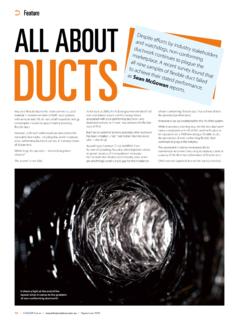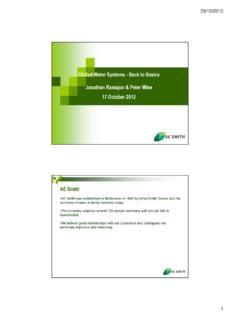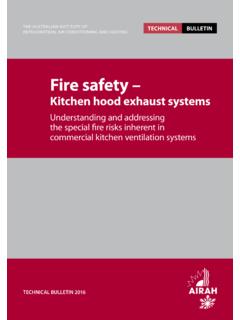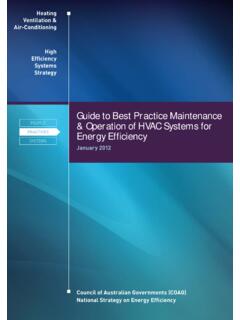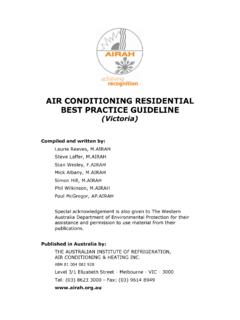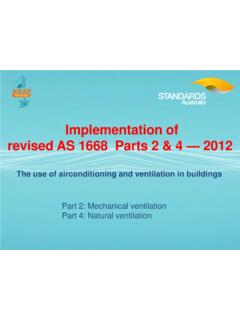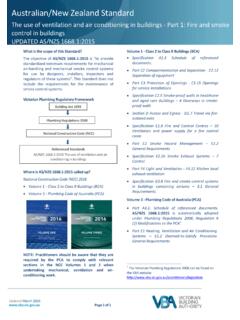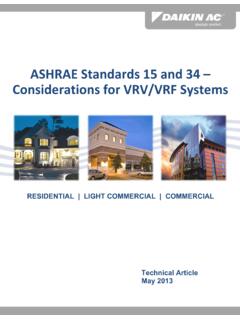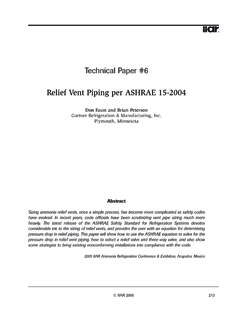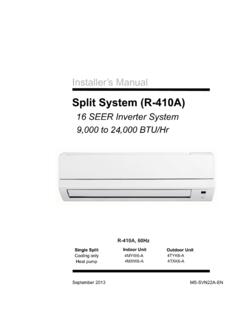Transcription of R32 Common Questions - AIRAH
1 1 R32 Common Questions September 2014 R32 Common Questions The following information has been prepared by the Air-conditioning and Refrigeration Equipment Manufacturers Association of Australia (AREMA) and the Consumer Electronics Supplier Association (CESA) as a service to the air conditioning industry, the general public and other stakeholders who have an interest in technologies to reduce the environmental impact of air conditioning appliances. The technical information contained in this document has been sourced from International Standards, Regulatory Codes and publically available Japanese and American Air Conditioning Industry Association reports. WHY ARE AIR CONDITIONING MANUFACTURERS CHANGING TO R32 refrigerant ? The decision by air conditioner manufacturers to transition to a new refrigerant is driven by many factors such as impact on the environment, energy efficiency, safety and cost effectiveness.
2 In many countries, HCFC 22 is still the dominant refrigerant . HCFC 22 is an ozone depleting substance and is being phased out in many countries as a result of the Montreal Protocol. In countries where HCFC 22 has already been phased out, the driving factor to transition to a new refrigerant is the desire to reduce the use of high Global Warming Potential (GWP) refrigerants. There is a diversity of low GWP refrigerants available to select from. These include HFC 32 (or R32), HFO 1234yf and HFO blends, Ammonia (R717), Propane (R290) and C02 (R744). Unfortunately, none of these candidates is a perfect refrigerant when assessed across the 4 key criteria of Environment, Energy Efficiency, Safety and Economy. Each refrigerant has strong and weak points, which also vary depending on the type of target product. Many major air conditioning manufacturers have determined that HFC 32 is the optimum choice for use in their products.
3 The benefits of HFC 32 are:- - Zero Ozone Depletion - 1/3 GWP of HFC 410A - Superior energy efficiency - High refrigeration capacity & thermal conductivity - Low pressure drop - Single component refrigerant easy to handle and recover - Low toxicity - Readily available (R32 is used in the manufacture of R410A which is a blend of 50% R32 & 50% R125) The primary negative characteristic of R32 is that it is classified as mildly flammable or lower flammability according to the International Standard for refrigerant Designation and Safety Classification, ISO 817:2014. WHAT DOES "LOWER FLAMMABILITY" / MILDLY FLAMMABLE MEAN? International Standard ISO 817:2014, segregates the flammability of refrigerants into 4 categories as follows:- no flame propagation (Class 1), lower flammability (Class 2L), flammable (Class 2) and higher flammability (Class 3).
4 In general language these classifications are called Non Flammable, Mildly Flammable, Flammable and Highly Flammable. R32 falls into the lower flammability or Class 2L "mildly flammable" category. 2 R32 Common Questions September 2014 Under ISO 817, any refrigerant and air mixture that is capable of self-propagating a flame falls into one of the three flammable categories. Class 2L refrigerants present the lowest risk of the 3 flammable categories and are defined by having a burning velocity of less than 10 cm per second. The characteristic of this low burning velocity is that the flame front does not propagate readily in a horizontal direction. This is because the convection rise due to combustion creates a higher velocity than the burning velocity. This effectively means that a Class 2L refrigerant is not explosive if ignited because the flame only propagates in an upwards direction from the ignition point and not rapidly outwards in all directions.
5 ISO 817 lists the burning velocity of R32 at cm/s ( km/h). In comparison the burning velocity of ammonia is cm/s, butane is 46 cm/s and hydrogen is 317 cm/s. The burning velocity of a gas is the speed of the flame front relative to motionless gas. The actual flame speed can be several times higher due to the expansion of combusting gas in combination with the burning velocity. This is especially applicable to A2 and A3 refrigerants as their higher heat of combustion generates rapid expansion and turbulence to dramatically increase the flame speed. ISO 817 also requires a Class 2L refrigerant to have a heat of combustion of less than 19 MJ/kg. R32 has a heat of combustion of MJ/kg. For ammonia it is MJ/kg, butane is MJ/kg and hydrogen is 120 MJ/kg. HOW EASY IS R32 TO IGNITE? For a gas mixture to ignite, 3 specific conditions must be met simultaneously.
6 1. The concentration of the flammable gas must lie between the Lower and Upper Flammability Limit (LFL and UFL) for the particular gas. For R32 this is between 14% volume (300 grams/m3) and 29% volume (620 grams/m3). It should also be noted that 14% concentration of any foreign gas in air is the accepted oxygen deprivation safety limit. Furthermore, a 14% concentration is well above the acute toxicity exposure limit for Common historical refrigerants like R22 ( ) and R134a (5%). 2. The second requirement is that the flammable gas mixture must have a velocity lower than 3 to 4 times its burning velocity ( cm / sec for R32). In the case of a wall mounted split system, because R32 is heavier than air any leaked refrigerant leaving the unit will exceed 4 times its burning velocity due to gravity within 40 cm.
7 Furthermore, measurements and computational fluid dynamic modeling has shown that even a rapid R32 leak of 1000 grams in one minute will not present a flammable mixture outside of the wall unit due to dilution and the falling velocity of the refrigerant . 3. The third requirement for ignition to take place is an ignition source of sufficient energy. Unlike Common flammable gases such as propane, R32 cannot be ignited by the usual static electricity we experience. Tests by independent laboratories in Japan and America1 have demonstrated that sparks from light switches or contactors in residential appliances do not have sufficient energy to ignite R32. Therefore, the most likely source of ignition in a residential application is an open flame such as a candle, combustion heater or gas cook top. Consequently, if an accidental release of R32 refrigerant occurs from a cylinder or piping , the velocity will be too high to ignite near the release point and the concentration will be too low where the velocity becomes low enough.
8 So, ignition of R32 is difficult even if it is attempted intentionally. Even if all 3 criteria are met simultaneously, other characteristics such as quenching distance can limit propagation should ignition occur. For example, if ignition occurred inside a large commercial circuit breaker, the flame will not propagate outside the circuit breaker enclosure unless the enclosure has openings bigger that the quenching distance (5-6 mm for R32). 1 DOE/CE/23810-92 - Risk Assessment of HFC-32 and HFC-32/134a (30/70 wt. %) in Split System Residential Heat Pumps 3 R32 Common Questions September 2014 WHY DOES THE R32 MSDS SAY EXTREMELY FLAMMABLE ? The flammability classification shown on all Material Safety Data Sheets is determined in accordance with the Globally Harmonized System of Classification and Labelling of Chemicals (GHS).
9 The GHS classification of flammable gases uses a simplistic approach: gases are classified only by the percentage concentration of gas required to create a flammable mixture in air. Other important factors such as how easy the gas is to ignite or how it behaves once ignited are not taken into consideration. Under the GHS classification, any gas that is ignitable at a concentration of 13% or less, or has a flammable range of at least 12 percentage points, is classified as a Category gas and is required to carry the hazard statement Extremely Flammable Gas . R32 has a flammable range of around 15 points so it meets the definition of the GHS for a Category gas. Ammonia has similar flammability characteristics to R32 and is also a Class 2L refrigerant . Ammonia has an LFL of (compared to for R32) and a flammable range around 14 percentage points2.
10 However, ammonia has historically not been categorized as extremely flammable in Material Safety Data Sheets from Ammonia suppliers. Ammonia is also a less dense gas than R32, so to reach its LFL, only 116 grams of ammonia per 1 cubic metre is required compared to 306 grams for R32. The Australian Dangerous Goods Code (ADG) also uses the same simplistic method for defining a flammable gas except that gases that have an LFL over 13% and a range under 12% are considered non flammable, where as the GHS classes such gases as a flammable gas (ie not extremely flammable). IS R32 TOXIC? All refrigerant gasses classified in ISO 817 can initiate some form of adverse health effect if the concentration is high enough, therefore it is technically incorrect to claim any classified refrigerant as non-toxic . However, compared to all other Common refrigerants, R32 requires the highest concentration level to cause any adverse health effect.
